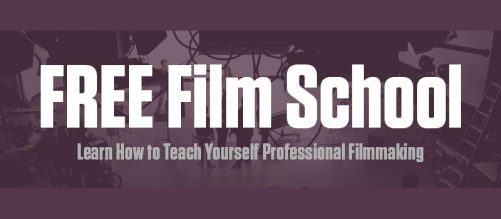FREE Film School: How To Use An Establishing Shot
The first page of the screenplay for the Oscar-winning movie Good Will Hunting starts like this:
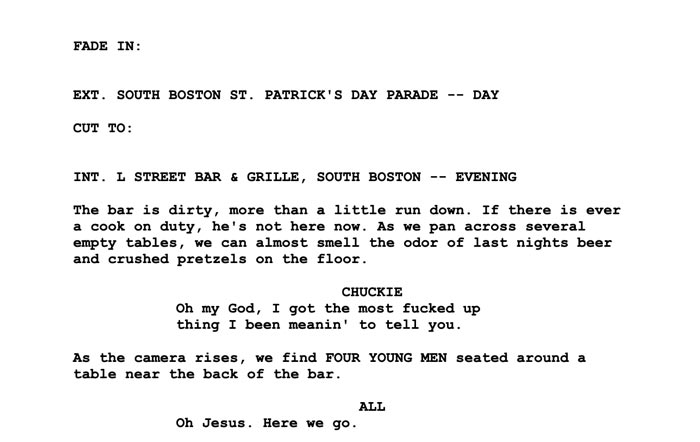
Eh? A scene heading without any description? What’s going on?
I don’t know for sure, but my guess is that the screenwriters (Matt Damon and Ben Affleck) are telling us this is the perfect place for an establishing shot. The purpose of an establishing shot is pretty self-evident, but it’s worth looking at how they are used and why.
You can learn so much from reading professional screenplays
I bet no screenwriting tutor has ever told a student to write a scene with no action. I remember well when I first started out as a screenwriter reading all the “how to” screenwriting books. But when I got my hands on some professional screenplays, I was like, “Hey, wait a minute…”
I saw that actually every professional screenwriter had a different style and a different way of conveying the story to the reader. Yes, the basic formatting rules are applied. But apart from that, there is room for creative flexibility.
One thing I learned to work on very hard was to prune my writing until only the best, most important action and dialogue was left in the screenplay. This was something my agent in L.A. hammered home to me. Script readers read hundreds or thousands of scripts and if you waste even 5 seconds of their time your screenplay could find itself in the trash.
And you can see from this opening page of an oscar-winning screenplay, Matt and Ben decided everyone knows what the St Patrick’s Day Parade looks like. So they don’t waste any reader’s time by pointlessly describing it.
But how many of us, after finishing screenwriter school, would feel the need to write some description there?
In fact, it’s these little details which indicate to the reader you are a pro. And the guys got their little clue in at line 1 of the script. Nice.
The Establishing Shot
An establishing shot literally establishes the location and setting for the following scene or sequence of scenes. Sometimes an establishing shot can set up the mood and location for the entire film. If it’s a one location film, for example.
In the above example, the script tells us we’re in South Boston. But also it indicates an Irish ancestry element to the film, which connects to the characters. Look at the names of the characters introduced in the sequence which follows: Sullivan, Hunting, McBride, O’Mally.
Because the establishing shot is there to orient the audience, they are almost always some form of wide shot.
How wide can you get?
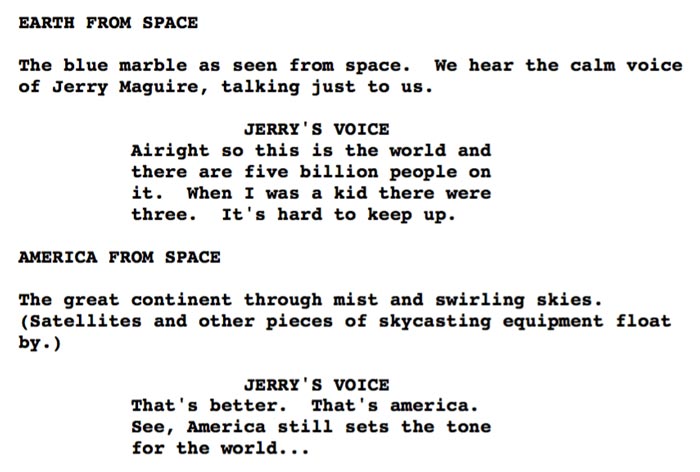
This is the first page from the Jerry Maguire screenplay by Cameron Crowe. It’s a rather imaginative way to establish the location and mood of a movie.
Crowe has us start in space, looking down on the entire planet. We then zoom and the script lands us in a baseball court, somewhere in America. So while the script tells us “this is America” it also implies America is the world’s most dominant country.
If you follow the screenplay, you can see it’s more a montage of establishing shots, rather than a single shot. Shots of 4 pro sportspeople in action, because this story is all about a tough-minded agent who represents leading American sportsmen and women.
So a series of images and brief scenes, all tied together with a voice over by the main character, serve to set up this movie. Now, the voice over continues right up until page 15 and this whole time the narration is used to introduce us to the plot – the situation, the characters, some back history and so on.
How about a black screen?
This is the opening page from the Lost In Translation screenplay by Sophia Coppola:
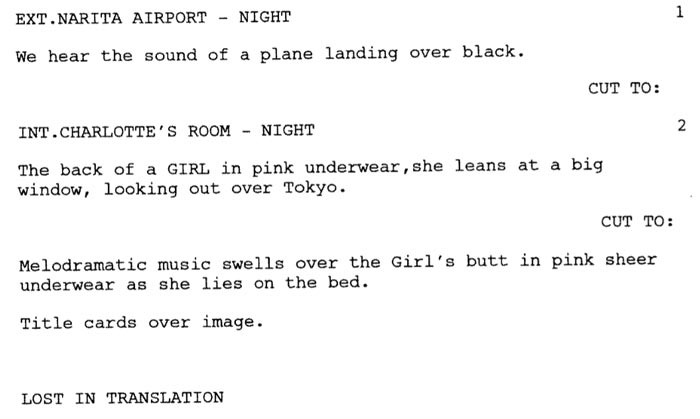
The establishing “shot” here is a black screen. Instead of image, Coppola uses audio to introduce us to the theme of the film. The simple sound of a plane landing is enough to indicate this movie is about… what? Travel?
What do you think about this idea? How will having nothing but a black screen and a sound effect make the audience feel here?
Having a black screen opening with some audio over the top is quite a commonly used device. It’s a way of gently introducing us to the story and it also makes us curious. We want this black screen to be replaced by an image so we can see the source of the sound.
In the case of this script, we never see the airport or the plane landing. So it’s nothing more than an audio clue. A kind of hint of a backstory to tell us one the main characters in the story has travelled a long way.
Whiplash
Another movie which opens using a black screen and audio is the film Whiplash (2014). Here’s the screenplay:
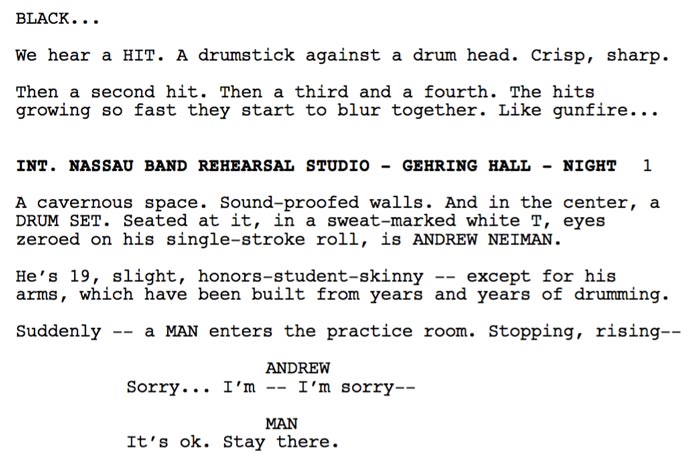
And here’s how that looks in the final movie.
Did that black screen opening from the script stay in the movie? Yep. As the dum beats reach a crescendo, a final hit takes us dramatically into the first shot of the movie – a wide establishing shot.
In this shot, the main character (Andrew Neiman) is sitting alone at the end of a cold looking corridor. This is not a jolly or a happy place. This shot tells us this place is serious, with the lines of the hallway zeroing in on the drummer at the end, like we’re looking down a gun barrel.
As the drummer starts to practice furiously, the camera sets off along the corridor towards him. This is really a very clear and simple establishing shot, drawing us into the story, allowing us to grow curious about this lonely drummer.
Then, the drummer sees someone and jumps up nervously. And as that someone is represented by the camera, it puts us (the audience) in the shoes of that character – a brutally exacting conductor called Terence Fletcher.
Now, the narrative of the film centres entirely on the power struggle between these two characters. So this establishing shot is used by the director (who also wrote the screenplay) to set up the location, the mood, the two main characters and the relationship dynamic between them.
And how does the Fletcher character enter the story? As a curious conductor who heard someone drumming and came to find out who. So we can see how the shot is used to put us in the mind of the Terence Fletcher character.
Why is this a good idea?
Because the writer/director of this film Damien Chazelle wants us (the audience) to also be curious about the hero of his film. He wants us to care about this lonely drummer. He wants us to want to know more about him, so then we’ll be gripped by the rest of the film.
Many opening shots are no more imaginative than a wide shot of a city, a wide of a building or a wide of a famous landmark (like the pyramids in Egypt or Tower Bridge in London, for example). But the opening shot in Whiplash is not just an establishing shot, it’s an establishing moment. The wide angle, the movement of the camera, the introduction of the two main characters – everything comes together to draw us into the story. The shot is not just setting a scene, it’s telling a story itself.
FREE Film School Lesson
You can teach yourself filmmaking by studying these aspects of successful films and applying them to your own work. If you are currently working on your own stories, do any of the ideas above inspire you to think differently about how you set up the story for your film?
Think about how the opening shots, sounds and moments introduce the characters and the feel and tone of the story that follows. If you feel confused about this opening moment, then don’t worry – this is normal. However, it might indicate there’s a confusion in your own mind about the story.
When we are uncertain of our story, we discover when we try to think about such things as opening scenes. Or writing loglines, for example. It’s not something to get down about, rather it’s all part of the learning and developing process as we become a better storyteller.
So, by thinking imaginatively about how you will introduce your story to an audience, you will be encouraged to think about your story as a whole. Until you are clear as to what your story is essentially about, it will be hard to think up an effective intro.
Good luck!
Eager to learn more?
Join our weekly newsletter featuring inspiring stories, no-budget filmmaking tips and comprehensive equipment reviews to help you turn your film projects into reality!
Simon Horrocks
Simon Horrocks is a screenwriter & filmmaker. His debut feature THIRD CONTACT was shot on a consumer camcorder and premiered at the BFI IMAX in 2013. His shot-on-smartphones sci-fi series SILENT EYE featured on Amazon Prime. He now runs a popular Patreon page which offers online courses for beginners, customised tips and more: www.patreon.com/SilentEye


